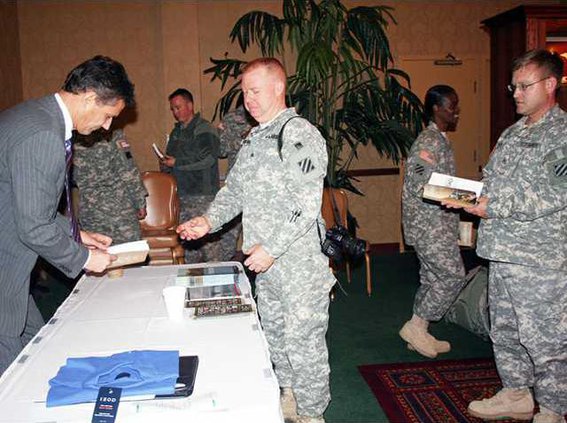Military historian and author Dale Andrade unveiled his latest book, which details the success of the 3rd ID’s work in Iraq during the 2007 troop surge, Monday at Fort Stewart’s Club Stewart. After the ceremony, Andrade signed copies of “Surging South of Baghdad: The 3rd Infantry Division and Task Force Marne in Iraq, 2007-2008,” which was released by the U.S. Army Center of Military History.
Andrade is the author of several military history books and is a senior historian in the center’s histories division, according to Fort Stewart’s public affairs office.
“We’re going to learn about our history here today,” announced Brig. Gen. Jeffrey Phillips to more than 100 soldiers who gathered for the occasion. “Welcome to this book debut.”
Phillips introduced Lt. Gen. Rick Lynch, commanding general of the U.S. Army Installation Management Command. Lynch, who formerly commanded the 3rd ID and the Multi-National Division-Center in Baghdad, was overseas for most of the Jan. 2007 troop surge in Iraq.
“Since we were going to make history, we might as well bring someone to write it down,” Lynch told the audience. “He [Andrade] captured history as we were making it.”
Lynch said Andrade rode with 3rd ID soldiers and, as a safety measure, also wore body armor into conflict zones. Andrade served 20 years in the military as well, the lieutenant general said.
“When I saw this book, I was proud and very appreciative,” said Lynch, who is quoted frequently throughout the 392-page publication. “Most importantly, it is written for all of you. It has been about us and this magnificent team. We all worked together to make this history.”
Andrade spoke to the audience about various aspects of the surge and included maps in his PowerPoint presentation of hot spots that troops penetrated during the surge. The historian collected documents, interviewed participants, prepared the book-length manuscript and worked with a military history detachment, he said.
The author emphasized the importance of rebuilding and spoke about his interaction with the 3rd ID and its commanding officers.
“That’s how you measure progress — are these peoples’ lives better?” he said.
According to a promotional media advisory released by Fort Stewart’s PAO office before the book signing, “Before the surge, the territory was a backwater used by al-Qaeda and other insurgent groups to recruit new fighters, construct roadside bombs and transport both to the ongoing fighting in Baghdad. One of the five new brigades that ‘surged’ into Iraq went to this region, more than doubling the number of U.S. forces already there and forming the southern anchor of the battle to sever this crucial link with the insurgents in the capital.
“The fighting south of Baghdad became something of a microcosm of the surge overall, an example of the necessity to combine troop strength with sound planning in order to defeat insurgents living among the population,” the release stated.
When the audience members were asked how many of them had been to Iraq, nearly every hand in the room shot up, a sign of the surge’s impact on the 3rd ID during the past eight years.
When Andrade concluded his presentation, the author and other 3rd ID officials participated in a question-and-answer session with the audience.
Soldiers then stood in line to thank the author and have their copies of the book signed.
Andrade is also the author of “America’s Last Vietnam Batttle: Halting Hanoi’s 1972 Easter Offensive” and is currently working on an official volume covering U.S. Army combat operations in Vietnam from 1969 through 1973.
Book details 3rd ID's role in Iraq surge
Author signs copes on post, talks to soldiers


Sign up for our e-newsletters